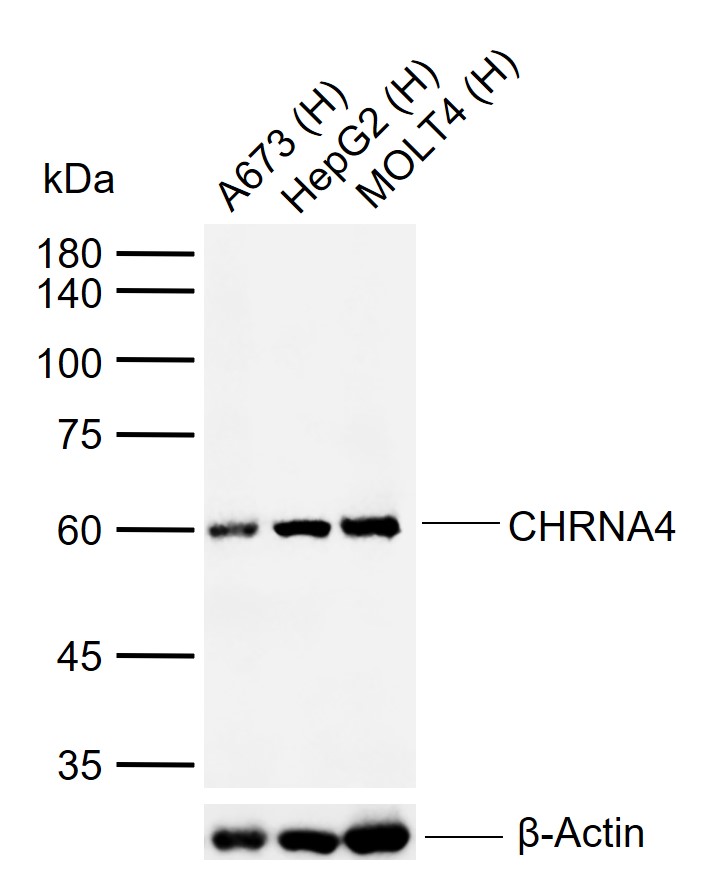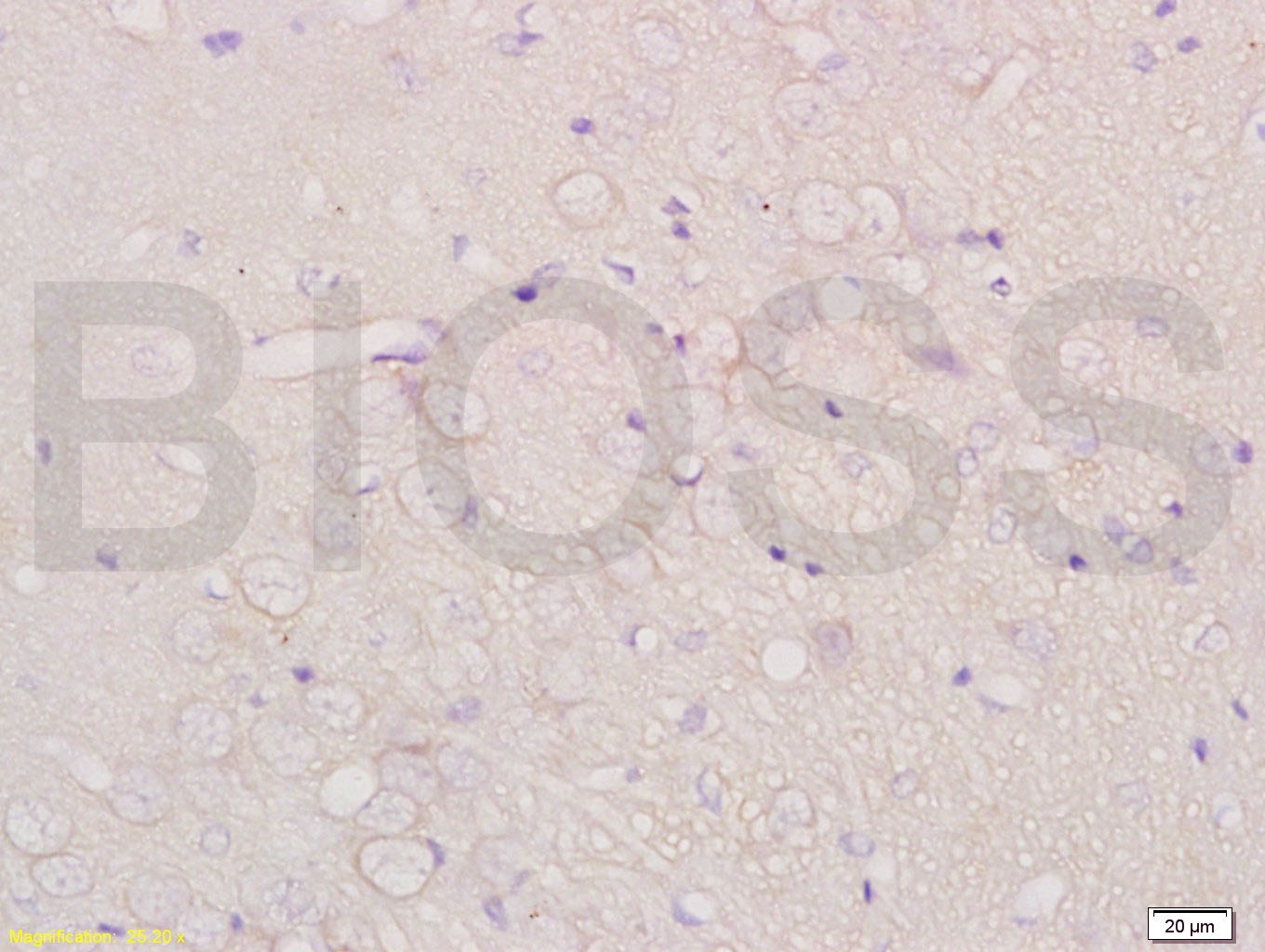
Details
| Product Name | CHRNA4 |
| Chinese Name | 烟碱型乙酰胆碱受体α4抗体 |
| Alias | Cholinergic receptor nicotinic alpha 4; Cholinergic receptor nicotinic alpha polypeptide 4; Cholinergic receptor nicotinic alpha polypeptide 4; cholinergic receptor, nicotinic, alpha 4; cholinergic receptor, nicotinic, alpha 4 subunit precursor; ACRA4; ALPHA-4NACHR; ALPHA4 ACHR; BFNC; CHRNA4; CHRNA 4; EBN 1; EBN; EBN1; ENFL1; FLJ95812; NACHR; nAChR alpha-4; NACHRA4; NACRA4; NARAC; Nicotinic Acetylcholine Receptor alpha 4; A4 nicotinic receptor; Acetylcholine receptor alpha 4 neural; Acetylcholine receptor neuronal nicotinic alpha 4 subunit; ACH 4; ACH4; Acra 4; Acra4; Alpha4 nAChR; BFNC; Cholinergic receptor nicotinic alpha polypeptide 4; ACHA4_HUMAN; NACRA 4; NACRA4; Neuronal acetylcholine receptor subunit alpha-4; Neuronal nicotinic acetylcholine receptor alpha 4 subunit; Neuronal nicotinic acetylcholine receptor alpha 4 subunit. |
| literatures |
Specific References (1) | SL1038R has been referenced in 1 publications.
[IF=4.367] Sallam MY et al. Brainstem cholinergic pathways diminish cardiovascular and neuroinflammatory actions of endotoxemia in rats: Role of NFκB/α7/α4β2AChRs signaling. Neuropharmacology. 2019 Jun 25;157:107683. IHC-P ; Rat.
|
| Research Area | Tumour Neurobiology Channel protein The cell membrane受体 The new supersedes the old |
| Immunogen Species | Rabbit |
| Clonality | Polyclonal |
| React Species | Human, Rat, (predicted: Mouse, ) |
| Applications | WB=1:500-2000 ELISA=1:5000-10000 IHC-P=1:100-500 (Paraffin sections need antigen repair)
not yet tested in other applications. optimal dilutions/concentrations should be determined by the end user. |
| Theoretical molecular weight | 67kDa |
| Cellular localization | The cell membrane |
| Form | Liquid |
| Concentration | 1mg/ml |
| immunogen | KLH conjugated synthetic peptide derived from human CHRNA4: 151-250/627 <Cytoplasmic> |
| Lsotype | IgG |
| Purification | affinity purified by Protein A |
| Buffer Solution | 0.01M TBS(pH7.4) with 1% BSA, 0.03% Proclin300 and 50% Glycerol. |
| Storage | Shipped at 4℃. Store at -20 °C for one year. Avoid repeated freeze/thaw cycles. |
| Attention | This product as supplied is intended for research use only, not for use in human, therapeutic or diagnostic applications. |
| PubMed | PubMed |
| Product Detail |
This gene encodes a nicotinic acetylcholine receptor, which belongs to a superfamily of ligand-gated ion channels that play a role in fast signal transmission at synapses. These pentameric receptors can bind acetylcholine, which causes an extensive change in conformation that leads to the opening of an ion-conducting channel across the plasma membrane. This protein is an integral membrane receptor subunit that can interact with either nAChR beta-2 or nAChR beta-4 to form a functional receptor. Mutations in this gene cause nocturnal frontal lobe epilepsy type1. Polymorphisms in this gene that provide protection against nicotine addiction have been described. Function: After binding acetylcholine, the AChR responds by an extensive change in conformation that affects all subunits and leads to opening of an ion-conducting channel across the plasma membrane permeable to sodium ions. Subunit: Neuronal AChR is composed of two different types of subunits: alpha and beta. Alpha-4 subunit can be combined to beta-2 or beta-4 to give rise to functional receptors, complexes with beta-2 may be heteropentamers. Interacts with RIC3; which is required for proper folding and assembly. Subcellular Location: Cell junction, synapse, postsynaptic cell membrane; Multi-pass membrane protein. Cell membrane; Multi-pass membrane protein. Cell membrane; Lipid-anchor (By similarity). DISEASE: Epilepsy, nocturnal frontal lobe, 1 (ENFL1) [MIM:600513]: An autosomal dominant focal epilepsy characterized by nocturnal seizures with hyperkinetic automatisms and poorly organized stereotyped movements. Note=The disease is caused by mutations affecting the gene represented in this entry. Similarity: Belongs to the ligand-gated ion channel (TC 1.A.9) family. Acetylcholine receptor (TC 1.A.9.1) subfamily. Alpha-4/CHRNA4 sub-subfamily. SWISS: P43681 Gene ID: 1137 Database links: Entrez Gene: 1137 Human Entrez Gene: 11438 Mouse Omim: 118504 Human SwissProt: P43681 Human SwissProt: O70174 Mouse Unigene: 10734 Human Unigene: 252369 Mouse Unigene: 9697 Rat |
| Product Picture |
Sample:
Lane 1: Human A673 cell lysates Lane 2: Human HepG2 cell lysates Lane 3: Human MOLT4 cell lysates Primary: Anti-CHRNA4 (SL1038R) at 1/1000 dilution Secondary: IRDye800CW Goat Anti-Rabbit IgG at 1/20000 dilution Predicted band size: 67 kDa Observed band size: 60 kDa
Tissue/cell: rat brain tissue; 4% Paraformaldehyde-fixed and paraffin-embedded;
Antigen retrieval: citrate buffer ( 0.01M, pH 6.0 ), Boiling bathing for 15min; Block endogenous peroxidase by 3% Hydrogen peroxide for 30min; Blocking buffer (normal goat serum,C-0005) at 37℃ for 20 min; Incubation: Anti-CHRNA4 Polyclonal Antibody, Unconjugated(SL1038R) 1:200, overnight at 4°C, followed by conjugation to the secondary antibody(SP-0023) and DAB(C-0010) staining |
Product Name CHRNA4 Chinese Name 烟碱型乙酰胆碱受体α4抗体 Alias Cholinergic receptor nicotinic alpha 4; Cholinergic receptor nicotinic alpha polypeptide 4; Cholinergic receptor nicotinic alpha polypeptide 4; cholinergic receptor, nicotinic, alpha 4; cholinergic receptor, nicotinic, alpha 4 subunit precursor; ACRA4; ALPHA-4NACHR; ALPHA4 ACHR; BFNC; CHRNA4; CHRNA 4; EBN 1; EBN; EBN1; ENFL1; FLJ95812; NACHR; nAChR alpha-4; NACHRA4; NACRA4; NARAC; Nicotinic Acetylcholine Receptor alpha 4; A4 nicotinic receptor; Acetylcholine receptor alpha 4 neural; Acetylcholine receptor neuronal nicotinic alpha 4 subunit; ACH 4; ACH4; Acra 4; Acra4; Alpha4 nAChR; BFNC; Cholinergic receptor nicotinic alpha polypeptide 4; ACHA4_HUMAN; NACRA 4; NACRA4; Neuronal acetylcholine receptor subunit alpha-4; Neuronal nicotinic acetylcholine receptor alpha 4 subunit; Neuronal nicotinic acetylcholine receptor alpha 4 subunit. literatures Research Area Tumour Neurobiology Channel protein The cell membrane受体 The new supersedes the old Immunogen Species Rabbit Clonality Polyclonal React Species Human, Rat, (predicted: Mouse, ) Applications WB=1:500-2000 ELISA=1:5000-10000 IHC-P=1:100-500 (Paraffin sections need antigen repair)
not yet tested in other applications.
optimal dilutions/concentrations should be determined by the end user.Theoretical molecular weight 67kDa Cellular localization The cell membrane Form Liquid Concentration 1mg/ml immunogen KLH conjugated synthetic peptide derived from human CHRNA4: 151-250/627 <Cytoplasmic> Lsotype IgG Purification affinity purified by Protein A Buffer Solution 0.01M TBS(pH7.4) with 1% BSA, 0.03% Proclin300 and 50% Glycerol. Storage Shipped at 4℃. Store at -20 °C for one year. Avoid repeated freeze/thaw cycles. Attention This product as supplied is intended for research use only, not for use in human, therapeutic or diagnostic applications. PubMed PubMed Product Detail This gene encodes a nicotinic acetylcholine receptor, which belongs to a superfamily of ligand-gated ion channels that play a role in fast signal transmission at synapses. These pentameric receptors can bind acetylcholine, which causes an extensive change in conformation that leads to the opening of an ion-conducting channel across the plasma membrane. This protein is an integral membrane receptor subunit that can interact with either nAChR beta-2 or nAChR beta-4 to form a functional receptor. Mutations in this gene cause nocturnal frontal lobe epilepsy type1. Polymorphisms in this gene that provide protection against nicotine addiction have been described.
Function:
After binding acetylcholine, the AChR responds by an extensive change in conformation that affects all subunits and leads to opening of an ion-conducting channel across the plasma membrane permeable to sodium ions.
Subunit:
Neuronal AChR is composed of two different types of subunits: alpha and beta. Alpha-4 subunit can be combined to beta-2 or beta-4 to give rise to functional receptors, complexes with beta-2 may be heteropentamers. Interacts with RIC3; which is required for proper folding and assembly.
Subcellular Location:
Cell junction, synapse, postsynaptic cell membrane; Multi-pass membrane protein. Cell membrane; Multi-pass membrane protein. Cell membrane; Lipid-anchor (By similarity).
DISEASE:
Epilepsy, nocturnal frontal lobe, 1 (ENFL1) [MIM:600513]: An autosomal dominant focal epilepsy characterized by nocturnal seizures with hyperkinetic automatisms and poorly organized stereotyped movements. Note=The disease is caused by mutations affecting the gene represented in this entry.
Similarity:
Belongs to the ligand-gated ion channel (TC 1.A.9) family. Acetylcholine receptor (TC 1.A.9.1) subfamily. Alpha-4/CHRNA4 sub-subfamily.
SWISS:
P43681
Gene ID:
1137
Database links:Entrez Gene: 1137 Human
Entrez Gene: 11438 Mouse
Omim: 118504 Human
SwissProt: P43681 Human
SwissProt: O70174 Mouse
Unigene: 10734 Human
Unigene: 252369 Mouse
Unigene: 9697 Rat
Product Picture
Lane 1: Human A673 cell lysates
Lane 2: Human HepG2 cell lysates
Lane 3: Human MOLT4 cell lysates
Primary: Anti-CHRNA4 (SL1038R) at 1/1000 dilution
Secondary: IRDye800CW Goat Anti-Rabbit IgG at 1/20000 dilution
Predicted band size: 67 kDa
Observed band size: 60 kDa
Tissue/cell: rat brain tissue; 4% Paraformaldehyde-fixed and paraffin-embedded;
Antigen retrieval: citrate buffer ( 0.01M, pH 6.0 ), Boiling bathing for 15min; Block endogenous peroxidase by 3% Hydrogen peroxide for 30min; Blocking buffer (normal goat serum,C-0005) at 37℃ for 20 min;
Incubation: Anti-CHRNA4 Polyclonal Antibody, Unconjugated(SL1038R) 1:200, overnight at 4°C, followed by conjugation to the secondary antibody(SP-0023) and DAB(C-0010) staining
Partial purchase records(bought amounts latest0)
User Comment(Total0User Comment Num)
- No comment




 +86 571 56623320
+86 571 56623320 SALES@SUNLONGBIOTECH.COM
SALES@SUNLONGBIOTECH.COM



